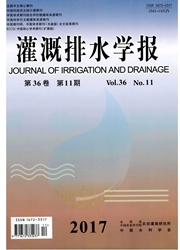

 中文摘要:
中文摘要:
2007年3~10月,在山东莱州海洋863中试基地,研究了海水养殖废水灌溉条件下,耐盐能源植物——菊芋的盐胁迫响应以及对氮、磷的吸收利用机制。结果表明:海水养殖废水灌溉条件下,菊芋地上部生物量(茎、叶)随着灌溉水盐度(S)的增加明显下降,盐度为9.46g/L的养殖废水处理生物量仅为淡水处理(CK2)的62.5%;地下部生物量(根、块茎)与盐度之间的关系符合一元二次方程曲线,且当盐度为3.83g/L时,地下部生物量取得最大值(0.205kg/株)。养殖废水处理菊芋地上部氮浓度明显低于淡水处理,地下部则各灌溉水处理间氮浓度没有明显差异;磷浓度地上部各灌溉水处理间没有明显差异。但地下部养殖废水灌溉处理明显高于淡水处理,表明海水养殖废水灌溉可以促进菊芋对磷的吸收,但氮利用受到显著影响。通过氮、磷通量计算,进一步证实了这一结果。
 英文摘要:
英文摘要:
Experiment was conducted to study the effect of saline aquaculture wastewater irrigation on nitrogen and phosphorus uptake by Jerusalem artichoke plant in Laizhou region, Shandong province, from Match to October, 2007. The results were described as follows: Above-ground biomass (stems and leaves) was decreasing with increasing salinity of irrigated water, and the aquaculture wastewater treatment with salinity 9.46 obtained the minimum value of above-ground biomass, which was only 62.5% of that as com- pared with freshwater irrigation treatment (CK2); however, the relationship between underground biomass and salinity of irrigated water accords with quadratic equation in one unknown, and when S= 3.83 g/L, the maximum underground biomass was obtained. The nitrogen concentrations of leaves and stems in saline aquaculture treatments were significantly lower than that in freshwater irrigation treatment; while, there were no significant differences in under-ground parts between aquaculture and freshwater irrigation treatments. The phosphorus concentrations of above-ground parts. However, exerted no differences between saline and freshwater irrigation treatments, but were significantly higher in saline irrigation treatments than that in freshwater irrigation treatment.
 同期刊论文项目
同期刊论文项目
 同项目期刊论文
同项目期刊论文
 Comparison of the response of ion distribution in the tissues and cells of the succulent plants Aloe
Comparison of the response of ion distribution in the tissues and cells of the succulent plants Aloe 期刊信息
期刊信息
